Presents
RATIONALE
India’s natural dye tradition has spanned several thousand years. When most of the world largely dressed in drab colours, India’s dye masters had perfected the art of using colourfast dyes to create rainbow colours by the use of mordants (substances that fix dyes onto cloth). Their dyeing traditions were handed down the generations, with no written records. What a tragedy that, in the 20th century, the collective knowledge of centuries of natural dye practitioners in India was largely wiped out with the advent of synthetic dyes. Just as many synthetic foodstuffs are poisoning our bodies, so the production of synthetic dyes is often toxic to the environment, whereas most natural dyes do not pollute land or water. It is therefore vital that Indian natural dye traditions are revived and passed on, with the help of specialists, from both India and abroad.
The Thomas Wardle documents in Kolkata consist of more than three and a half thousand samples of cloth and threads dyed with India’s indigenous dyes. Bound into 15 hard-back volumes, they are the world’s major extant documentation of India’s former dyeing expertise. Although these volumes have been digitized, it is of utmost importance that proper conservation is done to preserve these priceless documents.
Art conservation practitioner, strategist & educator
Director, Indian Museum, Kolkata
Specialist in 'historical aspects of plant heritage in India
Hortus Malabaricus, a 12-volume treatise written in Latin, is considered the earliest example of systematic documentation of Intangible Natural Heritage from Asia. It is the oldest comprehensive printed book on the natural plant wealth of Asia, compiled and published in Latin by Van Rheede (the then Dutch Governor of Malabar at Cochin) during 1678-1693. It contains illustrations of 742 plants belonging to 691 modern species, together with their descriptions and medicinal and other uses. All plants are described and illustrated under their local Malayalam names, written in Roman, Malayalam and Arabic scripts. In most cases, their Konkani, Portuguese and Dutch names are also given. It is perhaps the only authentic evidence of the ancient ethno-medical knowledge of Kerala, culled from the hereditary palm-leaf manuscripts by Itty Achuthan, a famous traditional Vaidyan of Kerala at that time. Three Konkani priest-physicians, Ranga Bhat, Vinayaka Pandit and Appu Bhat, supplemented the information. Br. Mathew of St. Joseph also collaborated with Van Rheede during initial preparation of the book.
About a century after its publication, Carl Linnaeus, the father of modern Botany, accepted Hortus Malabaricus as an authoritative manual on the plants of Asia and made extensive use of it when establishing his new binomials system of nomenclature of plants.
The book’s information on the medicinal use of plants described is of immense importance in the context of attempts being made in several countries to recover the TK and native wisdom related to various scientific disciplines.
Despite the unique importance of the book, Hortus Malabaricus has not been mentioned in any discussion on Intangible Heritage of Asia, because the entire text is in old Latin and thus not accessible to most Asians. Professor Manilal, from the University of Calicut, who has studied the various aspects of the original book for more than 35 years, produced the English translation (2003) about 325 years after its original publication. A Malayalam translation by Professor Manilal, will be published shortly.
The author has undertaken a series of programmes for interpreting the volume for common people through the medium of a museum (National Musuem of Natural History), e.g. seminars, conferences, workshops and exhibitions. A Museum Gallery on this important subject was established in RMNH Mysore. A National Conference on “Intangible Natural Heritage and Museums” organized by the NMNH (through its RMNH Mysore) in 2007 had a special session on Hortus Malabaricus. The Calicut Charter on Intangible Heritage and Museums, released during the occasion, highlighted the importance of Hortus Malabaricus as the earliest example of documentation (systematic and scientific) of Intangible Natural Heritage in Asia.
The UNESCO 2003 Convention on the Safeguarding of Intangible Cultural Heritage is the first international instrument towards safeguarding the ICH. However, the Intangible Natural heritage component of the IH is least studied. The publication, Hortus Malabaricus, which is considered the earliest systematic and scientific documentation of intangible heritage from Asia, fits as a case study for INH (intangible natural heritage) applicable to the UNESCO 2003 Convention on the Safeguarding of Intangible Cultural Heritage.
Scholar (Chay Root) and curator
This presentation describes a mission to identify natural red dye from chay root [Oldenlandia umbellata (Linn) or Hedyotis umbellata (Lam)], an important dye found in extant textiles of the Coromandel Coast of India. Reds and blues are the major colours found on historically traded textiles. A number of studies have been undertaken on natural indigo blue, and dyeing with indigo is a living practice; however, more study of traditional chay red dye is required. This presentation focuses on research in literary sources, on identification of chay plants in herbarium collections, and on field collection of the plant and processing and preparing red dyed samples, including failed attempts to fix the dye onto cotton cloth and on-going trials.
Designer, scholar
Most South East Asian countries have many ancient cultural practices in common, including the significance of using the colour yellow for various needs. The textile fraternity, in its concern about ‘Global Warming’, is rediscovering old techniques of using natural dyes and colorants for clothing and for food, and researching and rediscovering various natural dyes., Munnar is blessed with treasures like natural flora and fauna and clear spring water. This inspired us to start ‘Aranya Natural’ there, a heartwarming initiative which creates beautiful textiles coloured by extracts derived from nature’s bounty, in a spirit of sharing and honouring the earth and using the special talents of the differently abled youth of our population. This presentation will show how colours are derived from two of the raw materials, namely indigo and tea waste. This presentation looks at the colour yellow, because symbolically, it is the color of Indian Culture. At my natural dye farm in India, we have derived varying shades of yellow from many natural ingredients and successfully incorporated them into fashion textiles. This presentation opens with a visual journey through the historic and religious significance of Yellow in all Asian Cultures; in Malaysia [Royal Yellow], Japan and Thailand [Buddhist Monks’ Attire, Spiritual Yellow], Indonesia, Indian, Bangladesh, and Sri Lanka also people regard this color as both auspicious and medicinal. After this brief prelude, this presentation will cover, in depth, the practices of extraction and application of Yellow as done by us [for use in Textiles] i.e. yellows from Jack Fruit wood, marigold flowers, myrobalan gallnuts, and turmeric root.
It also touches on the topics of standardization, propagation, cultivation of bulk production, and it concludes with a note on design, finished products, and global market trends in eco-fashion.
Authority on Sir Thomas Wardle
For over 120 years a unique archive containing thousands of samples of India’s dyestuffs remained undiscovered in Kolkata. Over decades the samples were moved to various sites not recognized for what they were until Dr Debnath examined them in 2008.
Through years of doctoral and post-doctoral research on the work of Thomas Wardle, silk dyer, I had searched for the samples. All inquiries in England produced nothing and I never thought they would have endured the extremes of India’s climate. It was, therefore, thrilling when I heard the samples had been discovered in 2009, the centenary year of Thomas Wardle’s death. I was invited to take part in an exciting symposium in Kolkata in February 2010, arranged by Sutra to celebrate the find. On my first day in Kolkata I viewed the samples and realised what an astonishing achievement they were
Scholar, natural dyes worldwide
While ancient memoirs and dyers' books with cloth samples are comparatively rare documents which present complex problems of preservation, they are particularly precious as sources for academic, artistic and industrial research because they offer all the elements for understanding how to obtain a special colour from a range of plants and - more rarely – animals. They provide indispensable references for dye analyses of ancient textiles, and often represent the only certain evidence for the coloristic content of some colour names. In the present global context of revived interest in natural dyes and colorants for economic purposes, they can inspire new applications.
This paper will discuss historical examples of such type of sources: dyers’ notebooks with samples and sample cards preserved in the south of France, one of which has just been published by the author.
Director, Botanical Survey of India
Authority on textiles
Scholar (Indigo) Guest editor of
Marg special issue on natural dyes
Indigo, the most universally valued of all dyes, has linked the world since ancient times and continues to do so with the ubiquitous popularity of blue jeans, as well as the role it is playing in revivals of ecologically sustainable products. Its exotic story spans the arts and sciences, making it an ideal subject for inter-disciplinary education. This illustrated presentation will relate ways in which indigo can be used to engage school and college children, with a particular focus on ‘Silk Road Connect’, a curriculum developed at Harvard University and pioneered in classrooms in ‘under-served’ schools in New York City. This model could be adapted for other dyes, fibres and textiles.
Eco-friendly textiles and natural dyes are part of a sustainable green movement.
This presentation describes the presenter’s childhood experiences of playing in a river rich in wildlife in 1960s Spain, and seeing how the new developing industries polluted the water and killed most of the creatures living in it in just a matter of years. Witnessing the effects of environmental pollution at sixteen, he and his friends began to read about organic agriculture, sustainability, renewable energy, eco -industry and so on. Three years later, they cultivated a few acres of land following organic principles and started to make small electric wind generators, etc.
These experiences and reactions were being shared by millions of people in industrialized countries and gave birth the movement for an organic and sustainable society. However, banks and industries at that time, whose only concern was making money, considered such people to be utopians.
Nevertheless, despite many difficulties, groups of people started to sell organic products in marketplaces, and purchasers would pay extra for the products in order to support the ideal of a new fairer society free from and more humane.
This presentation emphasises how the sustainable green movement has not come from a marketing campaign but from the awareness of thousands and thousands of people of the dangers of polluting our world.
It explores how marketing starts with fully understanding the product and the target buyer.
Scientist (Chay root)
Oldenlandia umbellata L. syn. Hedyotis umbellata Lam, commonly known as Indian madder or chay root, belonging to the family Rubiaceae, is one such unexplored dye-yielding plant. It is suggested in a few reports that matured root of this plant, two years old, is the source of red dye. In a few reports it is stated that to date there is no proper protocol cavailable for the extraction of the red dye.
Hence the current research is focused on the collection of Oldenlandia umbellate from different geographical areas determination of plant age for dye extraction, and indentifying the best natural medium for maximum extraction of red dye from the root. Dyeing of red on cotton fabric was investigated and the dyed fabric tested for colour fastness, rub fastness and perspiration properties.
Former head of textile conservation
Victoria and Albert Museum, London
Chay root (Oldenlandia umbellata) has special significance in European textile history. The brilliant, luminous and fast red dye obtained from the root of the chay plant was a vital element in the manufacture of the painted and printed kalamkari textiles that began to filter into Europe in the mid sevententh century as a by-product of the spice trade. The establishment of the East India companies in Holland and England led to huge demands for these textiles. Their popularity in England threatened the wool trade and led to a prohibition on their direct import. This paper follows the history of chay root through accounts written by Western observers in the seventeenth and eighteenth centuries and outlines the extraordinary techniques that were perfected by Indian dyers over 4 millenia. Aspects of the techniques used to create specific effects with chay root are still not fully understood and current research into this question will be described.
Editor, Marg magazine; authority on Ladakh textiles
Natural dye practitioner, researcher, textile professional
In India, the yellow color signifies Joy & the Spring Season. In other words, it represents happiness and life. Marigold flowers are loved for their bright golden colors and used as a main floral décor in all festival & daily rituals in Indian households. When ceremonies or festivals are over, the discarded marigolds create huge quantities of temple waste or household garbage.
This illustrated presentation describes methods of recycling & reusing these discarded floral remains as a colorant for mix-match ranges of art and wearable textiles by using both traditional and contemporary techniques of decoration. It also describes the wider color potential of marigold as a dyestuff, not only for textile dying and printing but also as a paper colorant and for direct painting pigments.
Natural dye artist; co founder of 'Avani, Kumaon Hills
Avani is an NGO working in the Kumaon Himalayas for the past 16 years, creating rural livelihood opportunities through preservation of traditional crafts, appropriate technology and farm based activities. Avani’s work has reached more than 20,000 people in 101 villages. The participation of the community, respect for traditional knowledge, conservation and fair trade practices have been the corner stones of Avani’s work.
Avani has established two rural businesses – one based on natural textiles and lifestyle products and another on appropriate technology.
The textile enterprise, established as an artisans’ collective - Kumaon Earthcraft Self Reliant Cooperative - is based on the use of natural fibres and natural dyes. Earthcraft produces and markets high quality, eco- friendly, handmade textiles with natural fibres of silk and wool in natural dyes. This enterprise has revived the art of hand spinning and hand weaving in remote Himalayan villages and enabled women and local youth to earn a living close to their homes. Earthcraft also produces organic detergents, natural watercolors, hand knitted products and natural dye extracts and pigments.
Our entire cycle of production is based in the village. It begins with the planting of trees, sericulture, spinning, weaving and natural dyeing. The processes of production use clean energy (solar and biomass) and recycling of all the wastewater. We have integrated different elements of the rural reality into the creation of this enterprise that remains true to its environmental sensitivity.
Craft researcher and natural dye expert
The madder-dyed cotton excavated at Mohenjodaro in the 3rd millennium BC is indicative of its early history in the Subcontinent. Skill and artistic creativity of the Indian artisans are highlighted in ancient manuscripts, monuments and textiles and bear testimony to the durability of natural dyes. Yet centuries of knowledge and skill were largely lost in less than a hundred years with the discovery of aniline dyes from 1856.
Kamaladevi Chattopadhyay initiated the promotion of natural dyes in India in the '70s; she also inspired their revival in Bangladesh. Bangladesh has revived 30 colourfast dyes, including natural indigo. In the last three decades numerous training workshops have been conducted within the country and abroad and the commercial viability of organic dyes has successfully been established. This presentation will relate the story of this effective revival.
Assistant Professor
The motif designs and color schemes of Siamese chintz are different from Indian chintz made for other countries. This presentation explores design origin of Siamese chintz (‘Pha Lai-Yang’ in Thai), and motifs, patterns and color, as well reviewing the specific dye in India used for Siamese chintz.
It examines how ‘Traiphum’ text (contributed by King Li Thai in 14 th century, Sukhothai period) and the idea of ‘Bodhisattva’ got inseparably mingled in the design origin of Siamese chintz. Motifs of Thai/Siamese royal textiles had complex compositions; design and pattern, colour combinations and types of fabric selected conveyed important distinct symbolic messages of royal hierarchies.
Mythical animal motifs were mainly derived from ‘Traiphum’ text depicting Buddhist myths, while floral motifs were stylised and resembled stars associated with idea of ‘Bodhisattva’, such as lotus designs. Other motifs of Thai/Siamese royal textiles derive from divine forms in ‘Traiphum’ texts, such as the flame placed on the head of the Great Buddha statue as a symbol of enlightenment.
This paper looks at colour schemes and their symbolism in Siamese chintz. The Thai court sent sappanwood to India for specific dyeing of Siamese chintz.
Finally the presentation explores the way Thai royal textile design or Siamese chintz expressed the notion, prevalent in parts of Southeast Asia, that Thai kingship had a status similar to that of a ‘Bodhisattva’ (Future Buddha).
Scholar (Morinda citrifolia)
In spite of increasing urbanization and globalization of consumer tastes and market demand, craft traditions are alive and even today still a breathing part of India’s cultural and social life. However low demand and the availability of cheaper substitutes is leading to the extinction of some traditional practices.
The presentation will bring to light one such craft of natural aal (Morinda citrifolia) dyeing and handloom weaving in Bastar and Koraput districts of Chhattisgarh and Odisha. It was found that aal dyeing, which is still practiced at a very small scale in Kotpad village of Odisha has remained untouched by the other newer ways of natural dyeing. Morinda citrifolia belongs to the Rubiacea family and is also widely known as ‘Indian mulberry’. Therich colour achieved from aal varies from bright terracotta reds to maroons to deep browns and black. It remains true to the concept of traditional methods of natural dyeing with no modern substitutes.
The presentation will also highlight the adaptability of the traditional weavers to changes in material, layout and product design.
Research scholar & teacher (Indigo & Madder )
Standardizing natural dyes is problematic, and by its nature contradictory. Age old traditions of natural dyeing require a subtle combination of use of raw materials, skilful techniques and indigenous knowledge of dye recipes. It is therefore challenging to apply set standards when there are intangible as well as tangible parameters.
Colours, their local names and the perception of them too, show great diversity across the nation. Attempts to standardize natural dyes and dyeing can therefore perhaps best be achieved through meticulous documentation of rich local knowledge; i.e. by mapping of skills and local knowledge of raw materials, processes and resources using a pragmatic and empirical approach rather than a quantitative or precise one.
This presentation will explore how such research of natural dyes and dyeing can make rural and indigenous knowledge available to global markets by creating a greater understanding and appreciation of the multi-layered meanings of natural colours in all their variations.
Expert on natural dyes (Tea & Indigo )
Munnar is blessed with treasures like natural flora and fauna and clear spring water. This inspired us to start ‘Aranya Natural’ there, a heartwarming initiative which creates beautiful textiles coloured by extracts derived from nature’s bounty, in a spirit of sharing and honouring the earth and using the special talents of the differently abled youth of our population.
This presentation will show how colours are derived from two of the raw materials, namely indigo and tea waste.
Tea waste is obtained from factories after commercial tea is manufactured. The waste is rich in tannins that, combined with different mordants, produce a beautiful range of beige, brown and grey colours. Indigo (Indigofera tinctoria) is a natural plant dye procured from the growers and used since ancient times to create fascinating shades of blue.
Block-printing and natural dye expert
Rajasthan is known for colourful costumes, prints and jewellery in spite of its limited water resources. Textile arts, especially block printing, flourished in Rajasthan and are still practiced in some areas. Most of the textile printing centres in Rajasthan were situated close to fresh water sources, the major requirement of textile processing. This presentation will describe the production of textiles for costumes and for floor coverings in centres using natural or mineral dyes. Forms and details of designs distinguished castes and communities. Printed ‘ghagras’ (skirts), ‘ dans’ (long scarf for head covering) and turban prints made from cotton were made for different festivals, ceremonies and other occasions.
Block-printed textiles were largely made for the rural market except for Jaipur and Jodhpur where certain craftsman printed custom-made prints under royal patronage for the manufacture of royal costumes. Sanganer was among the famous centres where the printing was patronised by the royal family until the early forties.
Copyright © 2016 SUTRA TEXTILE STUDIES
Bessie Cecil
Jasleen Dhamija
Maria Wronska-Friend
Priti Nartiang
Rudolf Smend
Supriya Roy
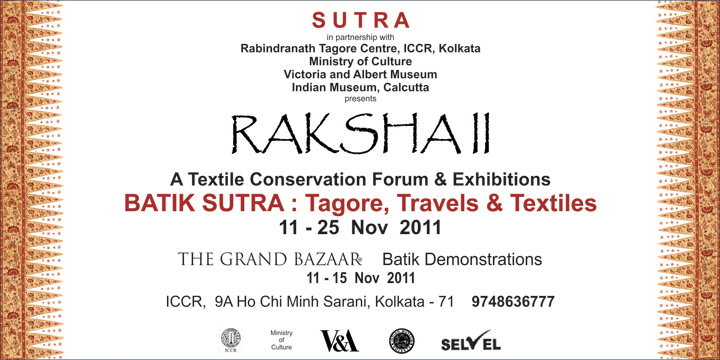
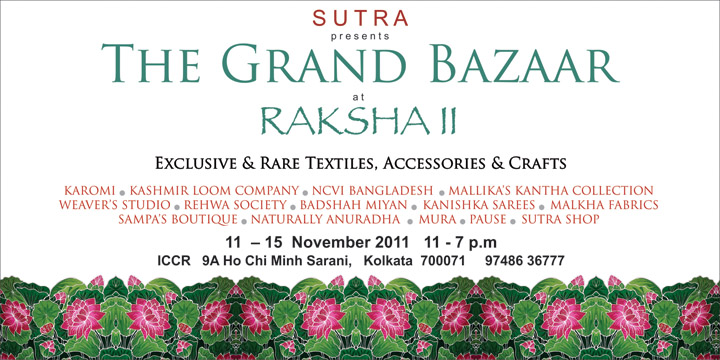
Copyright © 2016 SUTRA TEXTILE STUDIES
Sutra is proud to present Bengal Artist, Ajit Kumar Das, who has been working with natural dyes for a period of forty years. Urged on by a deep interest and perseverance in working with colours that can be obtained naturally, Das is inspired primarily by nature. Das’ art is not only a tribute to nature’s array of colours - it is an ode to his deep and sensitive interpretation of nature... one that exists on both physical and spiritual planes. Seeing the world through his intuitive 'third eye', Das incorporates symbols taken from Tantric religious art. In all of his work the concept of “Matri Shakti” or the personification of primeval energy, flows through.
20 FEBRUARY 2010 (Saturday) - 1600 hrs, Rabindranath Tagore Centre,
ICCR, Kolkata (ICCR)
Inauguration of VRIKSHA an exhibition of rare, natural dyed and patterned textile samples in the collection of the Botanical Survey of India (BSI), Kolkata.
This will showcase digitized photographs and some original documents from the Thomas Wardle set of natural dyed textile samples and the Forbes Watson set of plain and patterned textile samples from mid 19th century India, along with related objects.
21 – 27 FEBRUARY 2010 - 1100 to 1900 hrs, Bengal Gallery, ICCR
21 FEBRUARY 2010 (Sunday) – 0900 to 1730 hrs, ICCR
SEMINAR ON NATURAL DYES AND TEXTILE DESIGN
This seminar will focus mainly on the BSI collection of rare textile samples of the Thomas Wardle and Forbes Watson volumes from the 19th century. It will also discuss natural dyes and dye yielding plants, economic history, traditional & modern techniques of textiles conservation. Speakers will include:
After the seminar there will be brainstorming sessions for one hour each on specific topics of the seminar.
20-27 FEBRUARY 2010 - 1100 to 1900 hrs (specific time slots and venues to be advised later)
22 – 27 FEBRUARY 2010 – 0900 to 1730 hrs, ICCR & Indian Museum, Kolkata
22 FEBRUARY 2010 (Monday) - 0900 to 1730 hrs, ICCR
SEMINAR ON THE PRINCIPLES OF TEXTILE CONSERVATION
This seminar will give an overview of the principles of textile conservation in museums and private collections. It will cover the ethics of conservation; principles of minimum intervention and reversibility of treatment; evaluation, identification and documentation; causes of deterioration and treatment, amongst other topics. Speakers at the seminar-
After the seminar there will be brainstorming sessions for one hour each on specific topics of the seminar.
23 - 27 FEBRUARY 2010 - 0900 to 1730 hrs, Indian Museum, Kolkata
Principles of the techniques of cleaning and support of objects
This will cover amongst other things, the equipment and organization of a textile conservation studio; examination of textile objects; interventive techniques including cleaning and support of objects; display and good storage.
Workshop Leaders:
25 FEBRUARY 2010(Thursday)-0900 to1730 hrs, Indian Museum
(for participants of both workshop 1 & 2)
INTEGRATED PEST MANAGEMENT PROGRAMME
This will be an onsite visit to the Indian Museum, Kolkata.
Workshop Leader: Vinod Daniel, Australian Museum
20-27 FEBRUARY 2010 - 1100 to 1900 hrs, ICCR (opening on 20th Feb at 5pm)
AN EXHIBITION OF RARE BENGAL TEXTILES
20-27 FEBRUARY 2010 - 1100 to 1900 hrs, ICCR (specific time slots to be advised later)
DEMONSTRATIONS
20-27 FEBRUARY 2010 - 1000 – 2200 hrs, ICCR
DISPLAY AND SALE OF FINE INDIAN TEXTILES, TEXTILE CRAFTS and HANDICRAFTS
Optional TOURS OF TEXTILE CENTRES AND HISTORICAL SITES
* Please note that the 2 Conservation workshops can accommodate ONLY 20 candidates per workshop who will be selected by competent authorities on the basis of the filled up special workshop questionnaire submitted with along with registration form.
** Subject to minor alterations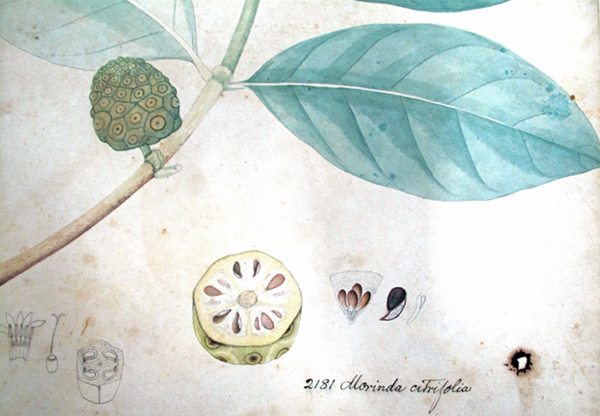
"From the collection of Flora Indica drawings by William Roxburgh, Central National Herbarium, Howrah,Bengal,India. Painted by local artists, late 18th century. (Photo Courtesy The Botanical Survey of India) "
* Please note that the 2 Conservation workshops can accommodate ONLY 20 candidates per workshop who will be selected by competent authorities on the basis of the filled up special workshop questionnaire submitted with along with registration form.
plants, shrubs, trees..
H. S. Debnath
Botanical Survey of India
M. Sanjappa
Botanical Survey of India
Mark Nesbitt
Royal Botanical Garden, Kew, United Kingdom
Monique Simmonds
Royal Botanical Garden, Kew, United Kingdom
garment, clothing, textiles..
Alice Cole
Switzerland
Pramod Kumar
India
Sujata Parsai
India
Vinod Daniel
Australia
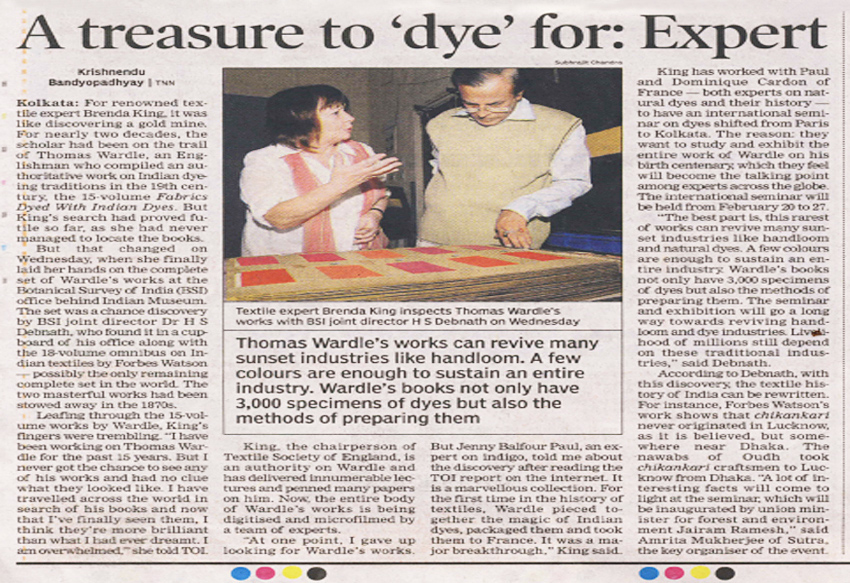
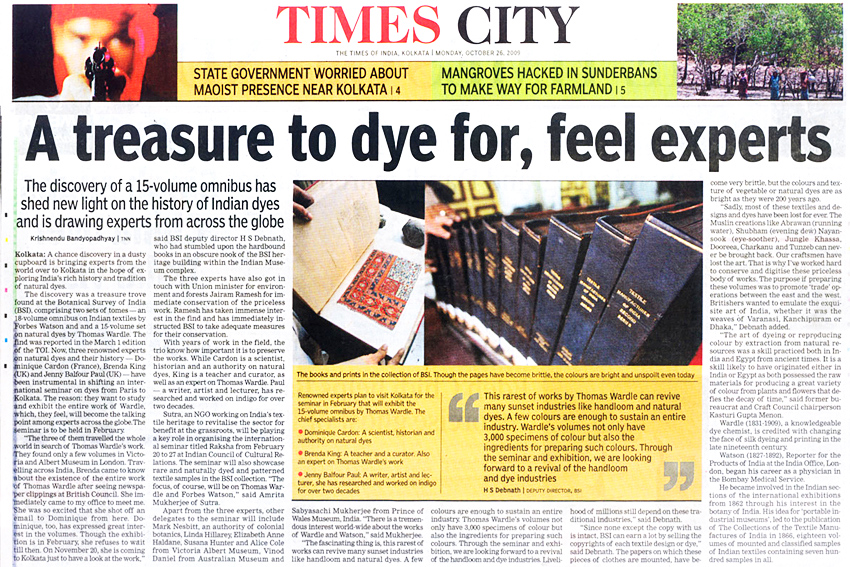
Departure at 10:15 hrs.
Walking trips to weavers on Jacquard Looms showcasing Dyeing, Reeling of Threads, Drumming and Pre-weaving stages etc.
Cost per delegate – INR 2050/- ( US$50)
Cost does not include -
Expenses of personal nature like shopping, beverages etc.
Cost – Rs.3450/- per delegate ( US$75)
Cost includes –
City Tour with Hutom Pyancha
For tailored tours around the city, book a half day or full day with Hutom Pyancha. On offer are many unusual perspectives of Kolkata and tours will be tailored according to your individual interests.
Click here to download the offer
The PARK Kolkata - (5 Star)
The Park, Kolkata, offers urban luxury at the best downtown location, which allows you to access the main commercial and entertainment districts of the city very easily. Post renovations, today, it wears a completely new look in rooms, restaurants,
and other public spaces.
For more details visit www.theparkhotels.com
The New Kenilworth - (4 Star)
The New Kenilworth, Kolkata, located at the very heart of the city, New Kenilworth Hotel, Kolkata is only minutes away from both the business hub as well as the major shopping malls and markets. New Kenilworth, Kolkata recognises the importance of offering luxury facilities to the business class traveller. The newly renovated Business Class Rooms are equipped with a personalised workplace cum entertainment center for your 24-hour workday.Time to experience Business Class.
Established in 1947 as The Kenilworth Guest House by Mr. H. Madath, the hotel had 42 rooms and two bungalows, and has now grown to a 102 room 4 Star Deluxe Hotel under the present management who have nurtured it since 1967.
Till the 1980s, the majority of the patrons of New Kenilworth were foreigners and expatriates including guests of foreign
consulates, celebrity jockeys from England, renowned writers and professionals. Celebrities from all walks of life
have been delighted with the warmth and hospitality the Hotel offers. As a hotel with a history, New Kenilworth lives up to its
colonial benchmarks of service and takes pride in its warm and friendly employees and impeccable customer care.
For more details visit www.kenilworthhotels.com
The ASTOR - (3 Star)
Located in downtown Kolkata, The Astor hotel adds quaintness to the otherwise bustling map of the Kolkata CBD. The hotel is placed in the heart of the city yet tucked away from the razzmatazz of Park Street. More than three decades old, The Astor is housed in a 110 year Victorian red brick building which has bestowed a vintage value on the hotel.The Golden Park - (4 Star)
The Golden Park (Kolkata) is your home away from home, situated right in the heart of Kolkata, with most Corporate Houses, Shopping Malls and sight seeing, in and around us. This intimate and exclusive hotel consists of 72 boutique rooms and 14 Conference halls, excellent in exceeding expectations with continued commitment to service and fine attention to details.The Rainey Court Residency
The Rainey Court Residency" is a boutique premiere "Hotel" located in the crème-a-crème posh neighbourhood of Ballygunge Circular Road in South Kolkata. Its about 45 minutes drive from airport to "Rainey Court Residency". The "Hotel" is conveniently located with easy access to CBD, Shopping Malls, Multiplexes, Schools, Hospital, Metro Station, Railway Station within a radius of 5-7 km.Specially negotiated rates for SUTRA inclusive of breakfast –
Single- Rs.1800/- per room per night + 5% luxury tax
Double – Rs.2000/- per room per night + 5% luxury Tax
Copyright © 2016 SUTRA TEXTILE STUDIES
INTERNATIONAL CONFERENCE AND EXHIBITION ON THE HISTORIC TEXTILE TRADE OF INDIA, HELD IN KOLKATA, IN OCTOBER 2003
In October 2003, SUTRA organized an international conference and exhibition in Kolkata, on the centuries old textile trade between India and the world, called,
“SUTRA: Thread, Ties and Transformations: Two thousand years of Textile Trade between the Indian Subcontinent and the World”
Twenty three international scholars from India, Bangladesh, Pakistan, UK, Germany, Australia and USA, presented papers at this three day conference which was coordinated by Ms Rosemary Crill, Senior Curator of the Asian Section of the Victoria and Albert Museum, London, the repository of some of the best archival Indian textiles in the world.

EXHIBITION OF RARE TRADE TEXTILES
‘Indian Textiles: the trade to East and West’
An exhibition of rare, historic Indian trade textiles from the 13th century onwards, found in countries as far apart as Indonesia, Thailand, Portugal and England, taken on loan from the ‘Tapi’ Collection of Mr and Mrs Praful and Shilpa Shah of Mumbai and Surat, was held alongside the conference and was the highlight of the event.
This was the very first time that Indian trade textiles were the focus of an exhibition in India.
A book, documenting the papers of the conference and edited by Ms Rosemary Crill was published in 2005, called,
‘Textiles from India: the Global Trade’
This book documents fascinating aspects of India’s textile trade to Asia, Africa, Europe and America and includes a chapter on a 1740s shipwreck with a cargo of textiles and dyestuffs.
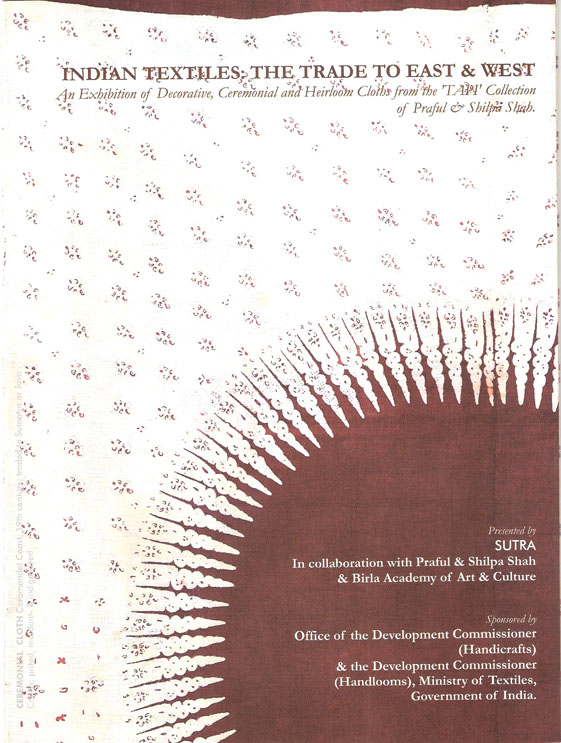
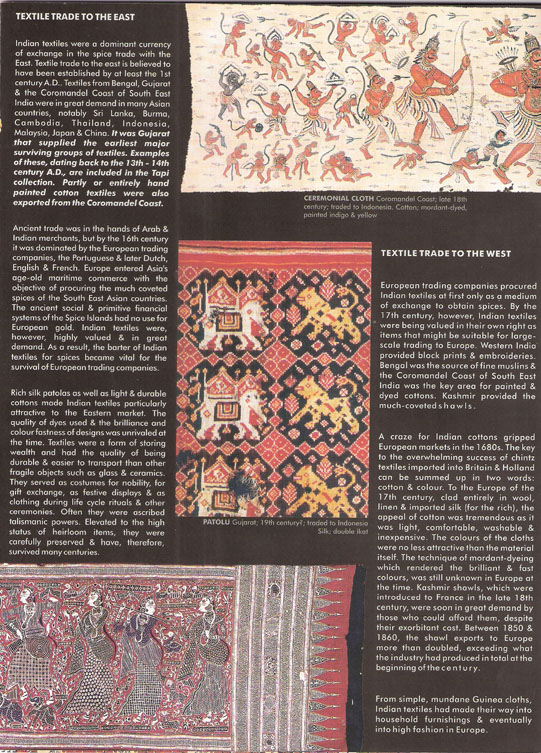
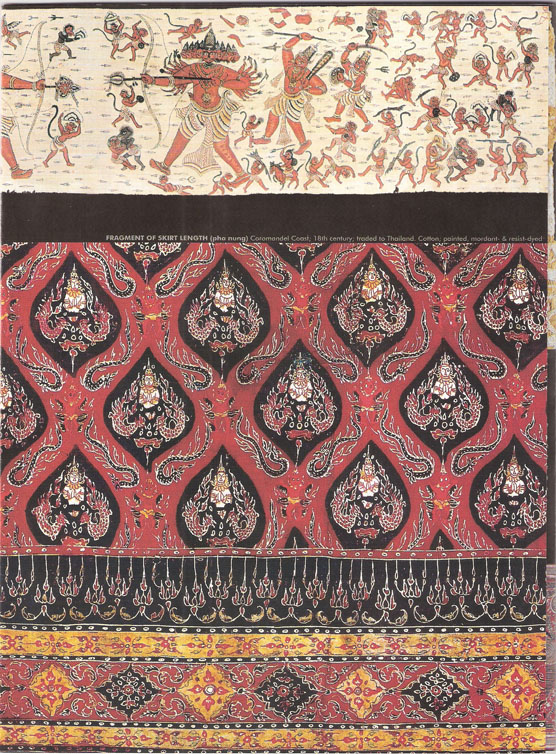

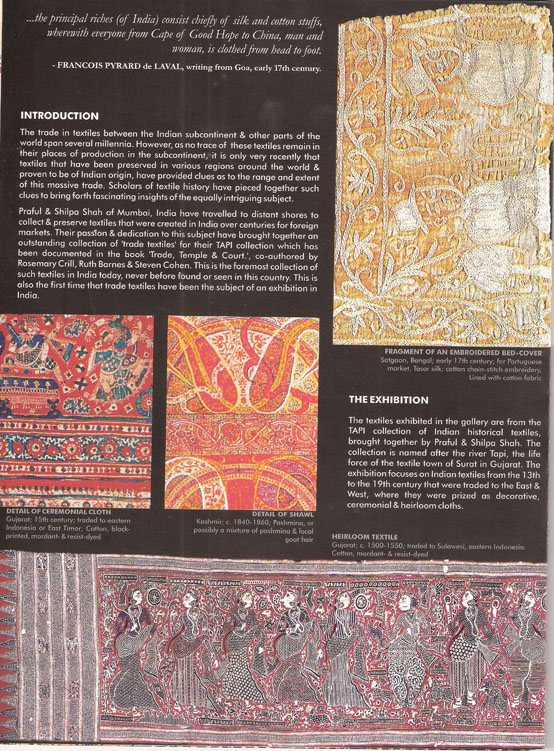
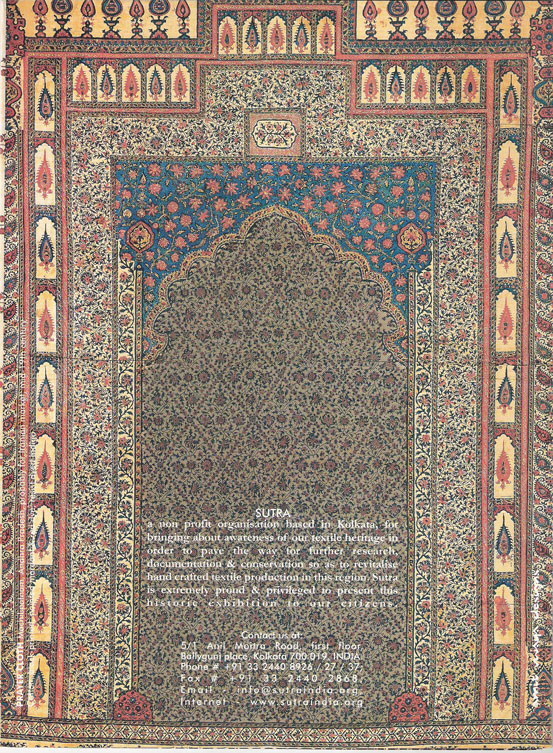
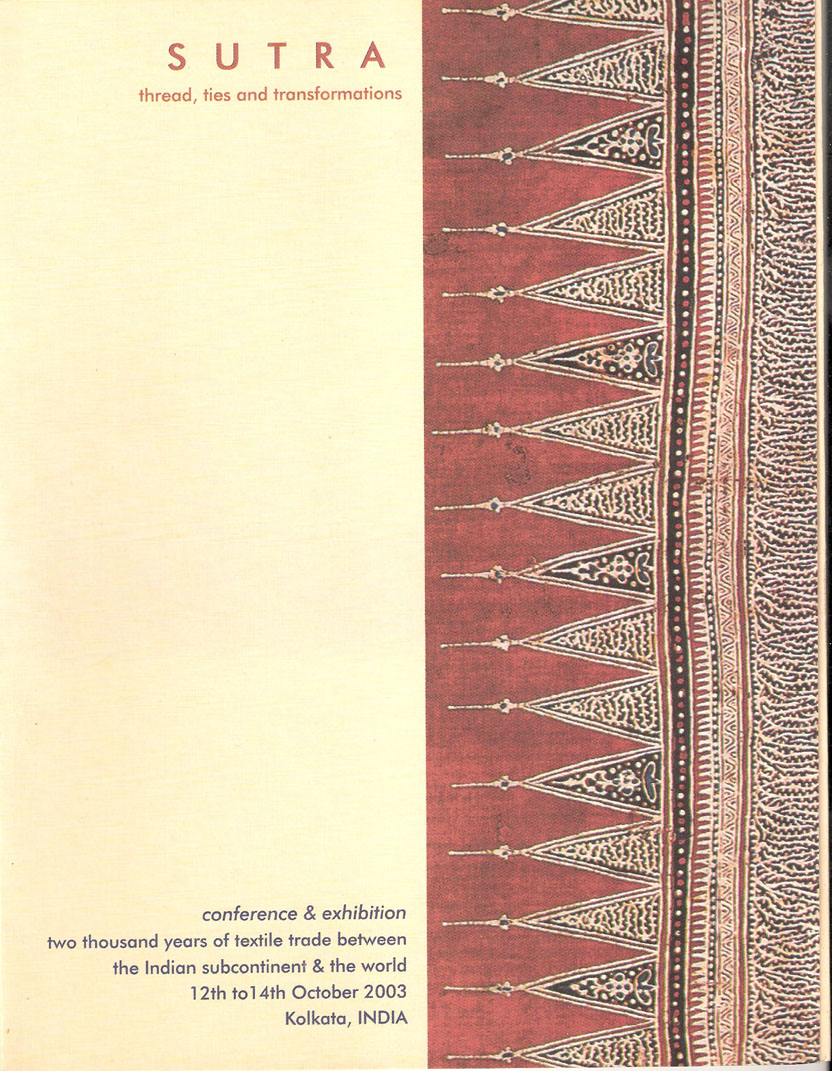
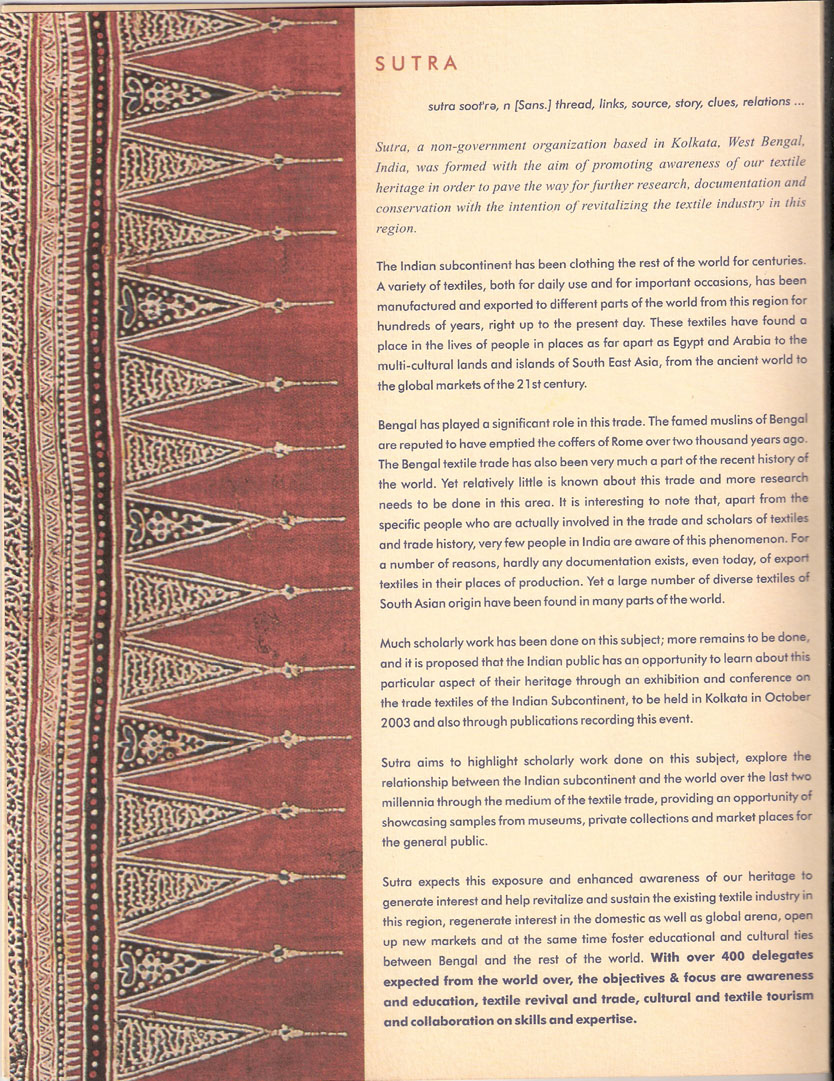
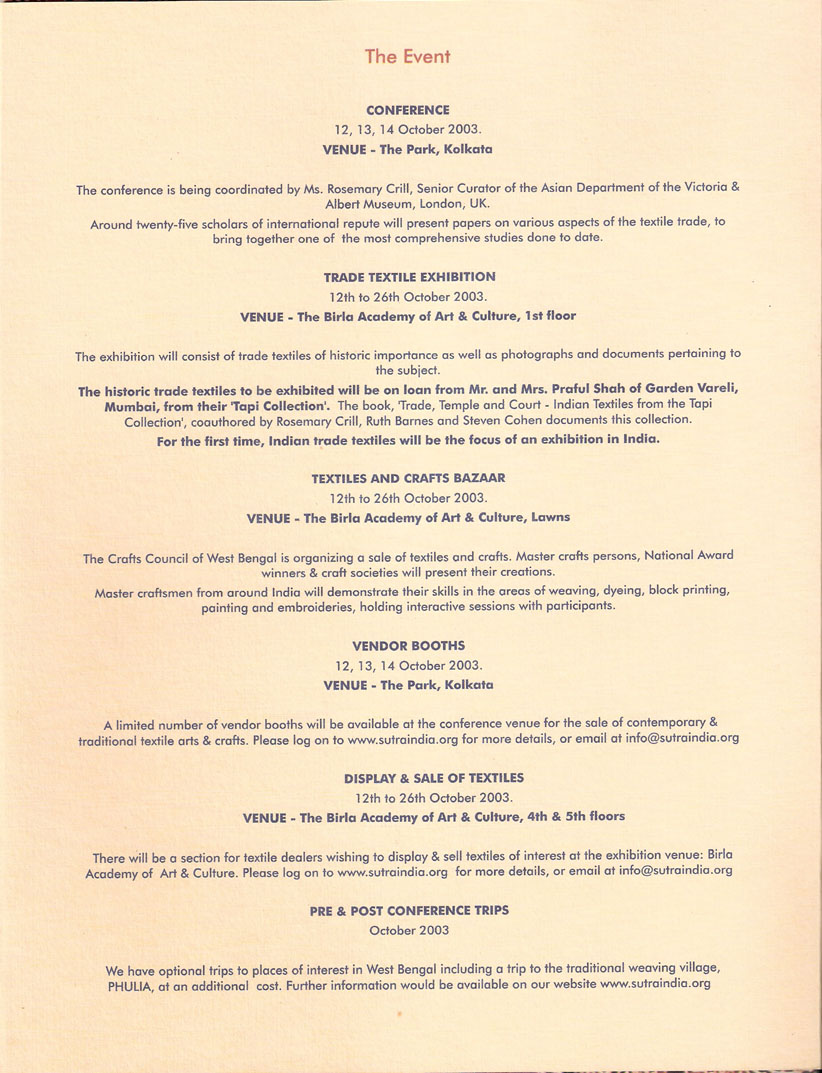
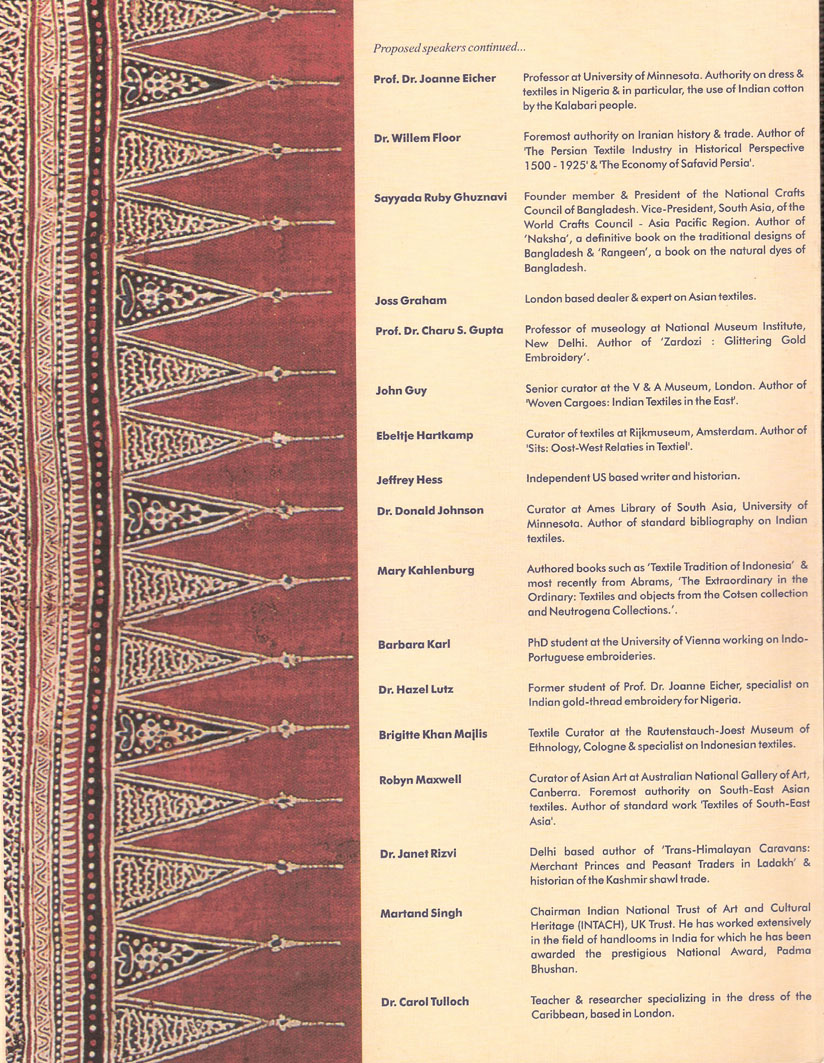
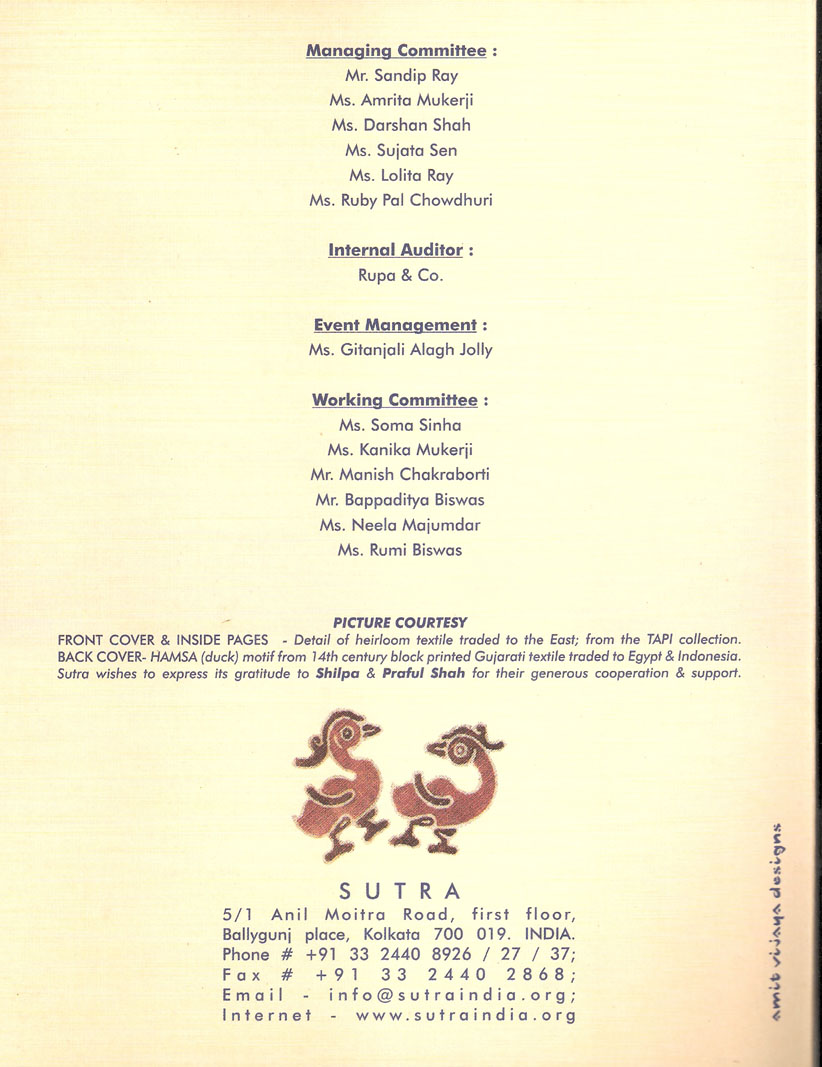
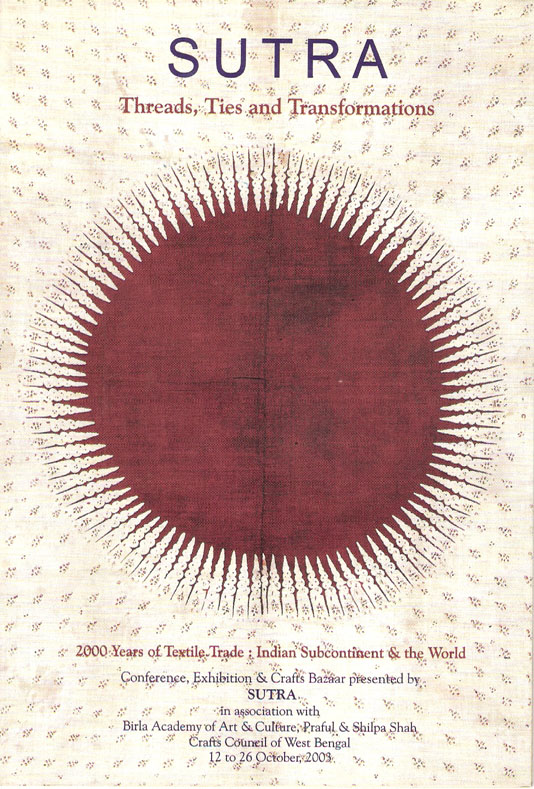
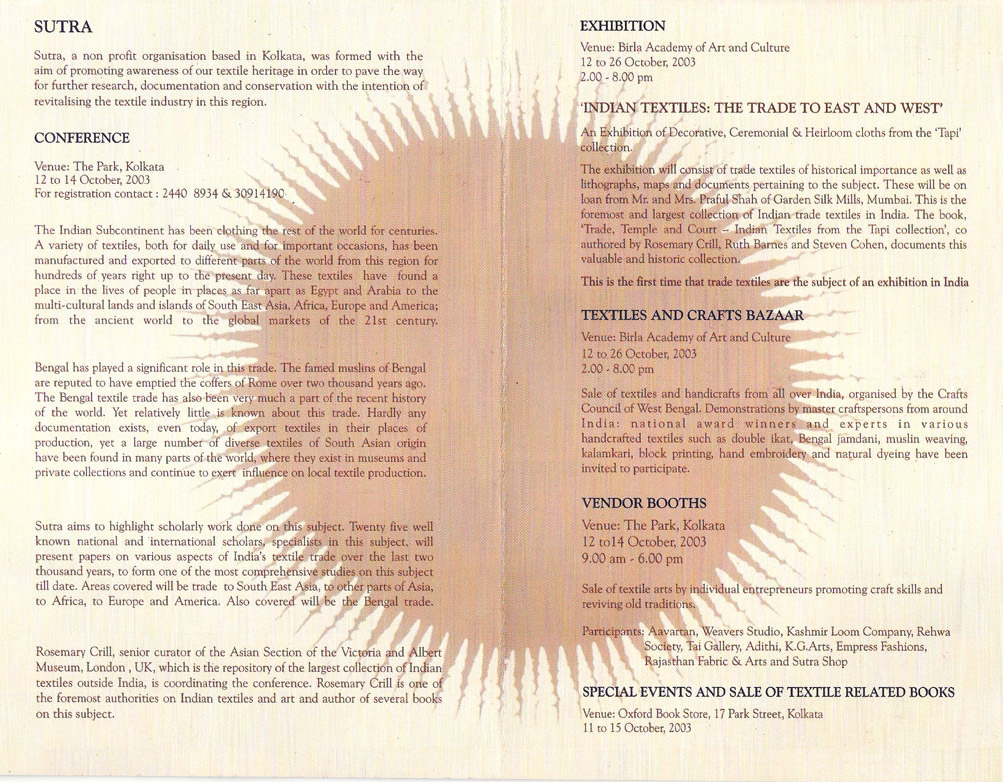
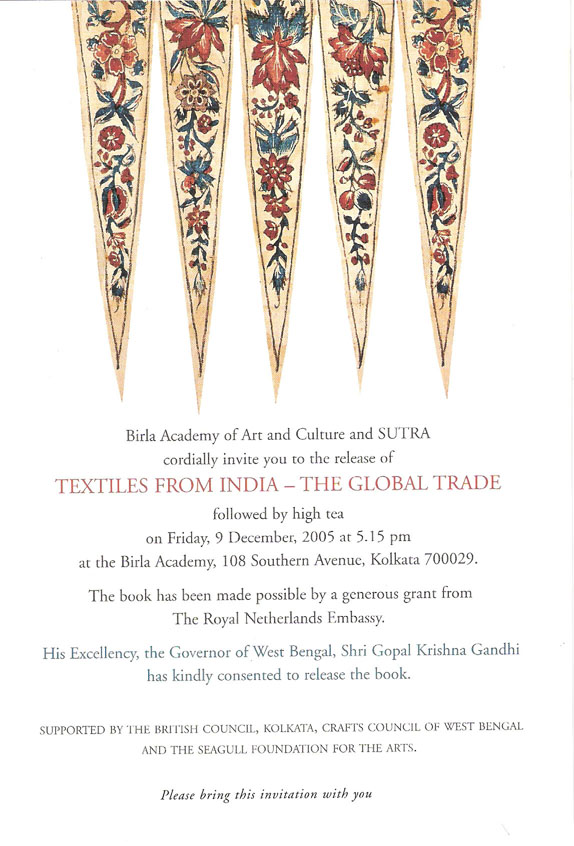
Copyright © 2016 SUTRA TEXTILE STUDIES